FUEL RENEWAL
Is hydrogen the gas with mass appeal?
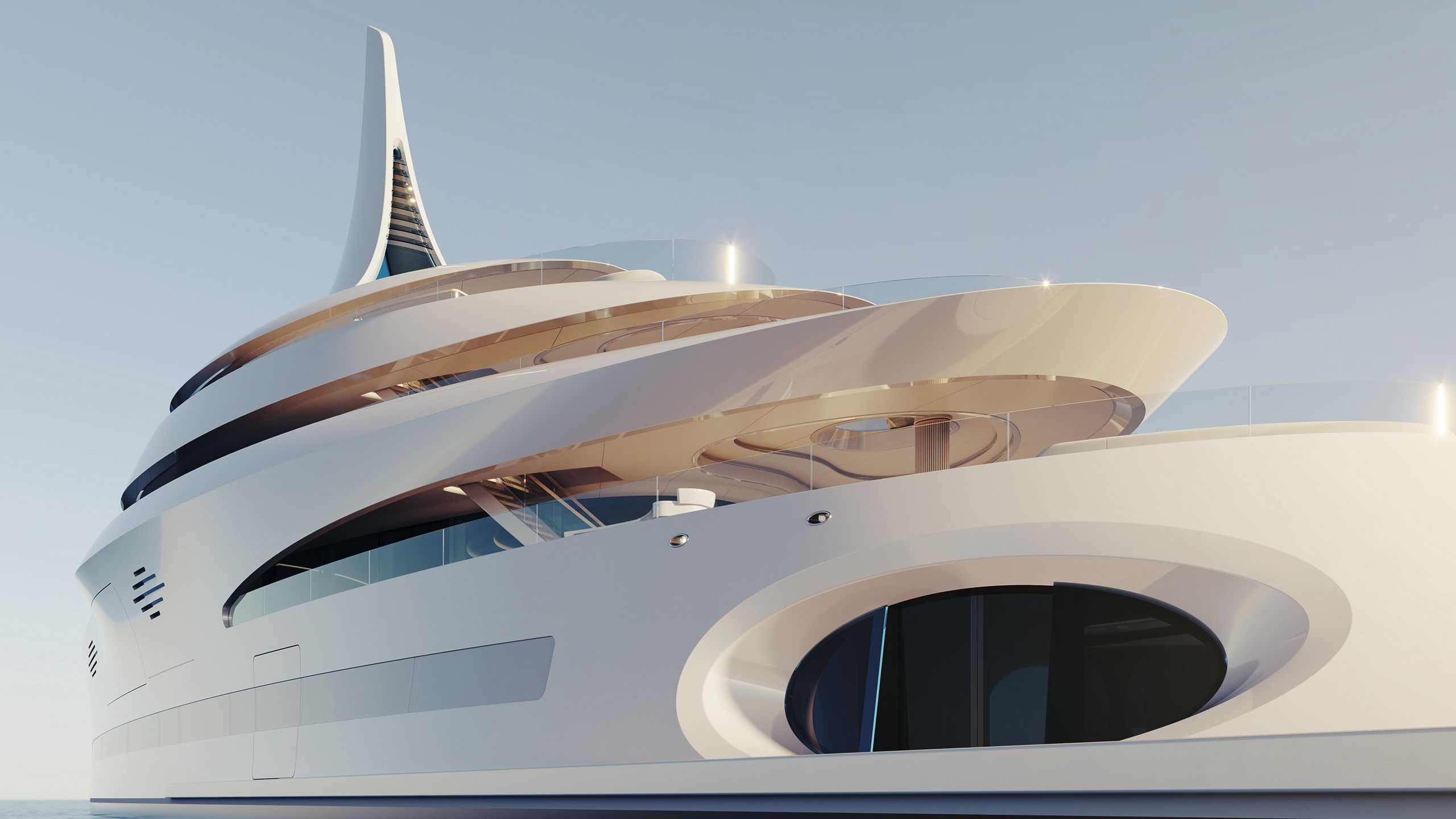
Hydrogen fuel cells have been hailed as the future of green yachting, but it’s a little more complicated than that, as Sam Fortescue discovers
FEADSHIP
Humanity had to wait until 1965 before someone at Siemens thought of using a hydrogen fuel cell to drive a boat round a pond in Bavaria. We’d known of its potential since Sir William Grove built a “gas battery” in 1842, but the technology has come on in leaps and bounds in the past two decades. Now the brightest minds in boatbuilding believe it may hold the key to silent, carbon-free power and guilt-free yachting. Shipping may produce only three per cent of global emissions, with superyachts a vanishingly small sliver of that, but for some that is not the point. “Safeguarding the sea is essential, as a common good of inestimable value; a collective obligation that directly affects our industry,” says Massimo Perotti, executive chairman of Sanlorenzo. “Building today the sustainable boats that will ply the seas of tomorrow means being a spokesperson for an environmental and moral revolution.”
It is a view echoed by the owner of the 50Steel yacht that Sanlorenzo is currently building with a fuel cell. “Adopting cutting-edge green technology such as hydrogen fuel cells undoubtedly brings practical advantages,” he says. “But it is primarily a choice rooted in a world view and a particular commitment to sustainability. It also reflects a personal spirit of experimentation and innovation. Currently, all components are prototypes and therefore expensive, but if, as hoped, a broader adoption of this new system takes off, economies of scale and the amortisation of design expenses will gradually lower the costs. The same applies to green fuel: today it is still quite expensive, but it is clear that the price will decrease as market demand increases in the coming years.”
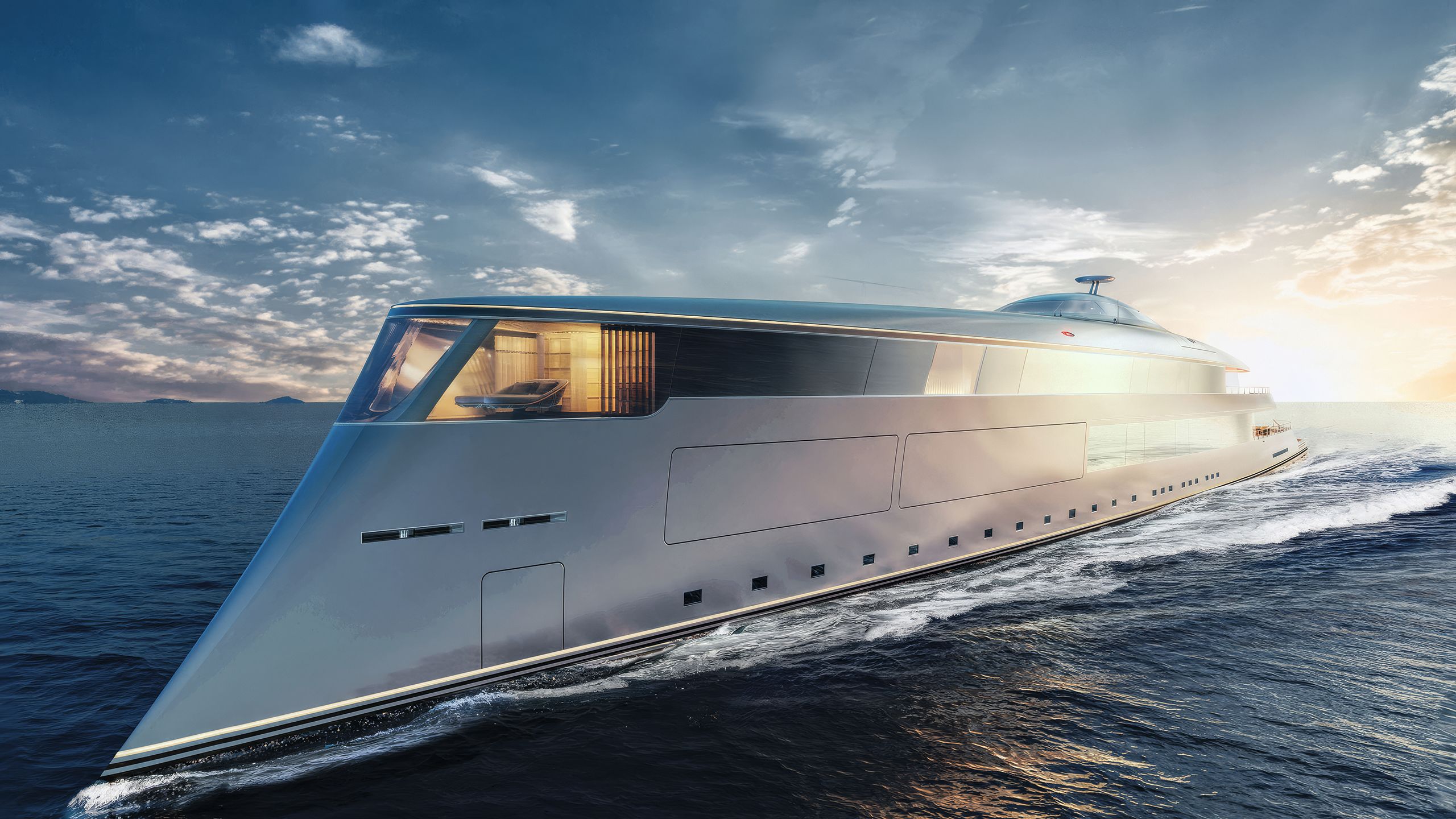
SINOT YACHT ARCHITECTURE AND DESIGN Sinot’s 112-metre hydrogenelectric yacht concept Aqua relies on hydrogen as fuel
SINOT YACHT ARCHITECTURE AND DESIGN Sinot’s 112-metre hydrogenelectric yacht concept Aqua relies on hydrogen as fuel
If the revolution is already well under way at Sanlorenzo, Lürssen is not far behind with its 114-metre Project Cosmos, and Feadship is also building a 100-metre-plus yacht with a hydrogen fuel cell. Other yards are at the concept stage, such as Baglietto with its Bzero system, which generates renewable power to turn water into hydrogen fuel.
The beating heart of all these hydrogen-based projects is a device that extracts electricity from hydrogen without resorting to combustion – the fuel cell. You feed it with hydrogen and air at one end, producing water at the other. Electricity is merely a by-product of this process. There are many different types, but the most common in vehicles is the proton-exchange membrane (PEM) fuel cell. Every individual cell is only a few millimetres thick and generates a tiny voltage of 0.5V to 1.0V, so you need to combine lots of them in a stack to harvest meaningful power. Big stacks can contain thousands of individual cells.
Unfortunately, this membrane is a consumable part that wears out, but research is having an impact here. “First-generation fuel cells lasted between 5,000 and 8,000 hours before requiring membrane replacement,” says Sanlorenzo’s Perotti. “The lifespan of the second-generation fuel cell that we are working on with our technical partners will reach 25,000 to 30,000 hours.”
Boatbuilders are also designing their fuel cell stacks for simple replacement, so it has already become less intrusive than swapping out a worn-out engine. Unfortunately, you can’t simply put the throttle to the dash and expect the fuel cell to produce power on demand, as you would with a diesel engine. It takes time to ramp up, and heavy peak loads can cause damage, shortening its lifespan, so you need a large battery bank to sit between the power consumers and the fuel cell. This has made boatbuilders and designers cautious about using the system to drive the boat as well as cover the hotel load. “By the end of the decade, with experience of fuel cells and the next generation of technology, we think it might be feasible to power a yacht with a single fuel cell,” says Feadship’s head of R&D, Giedo Loeff.
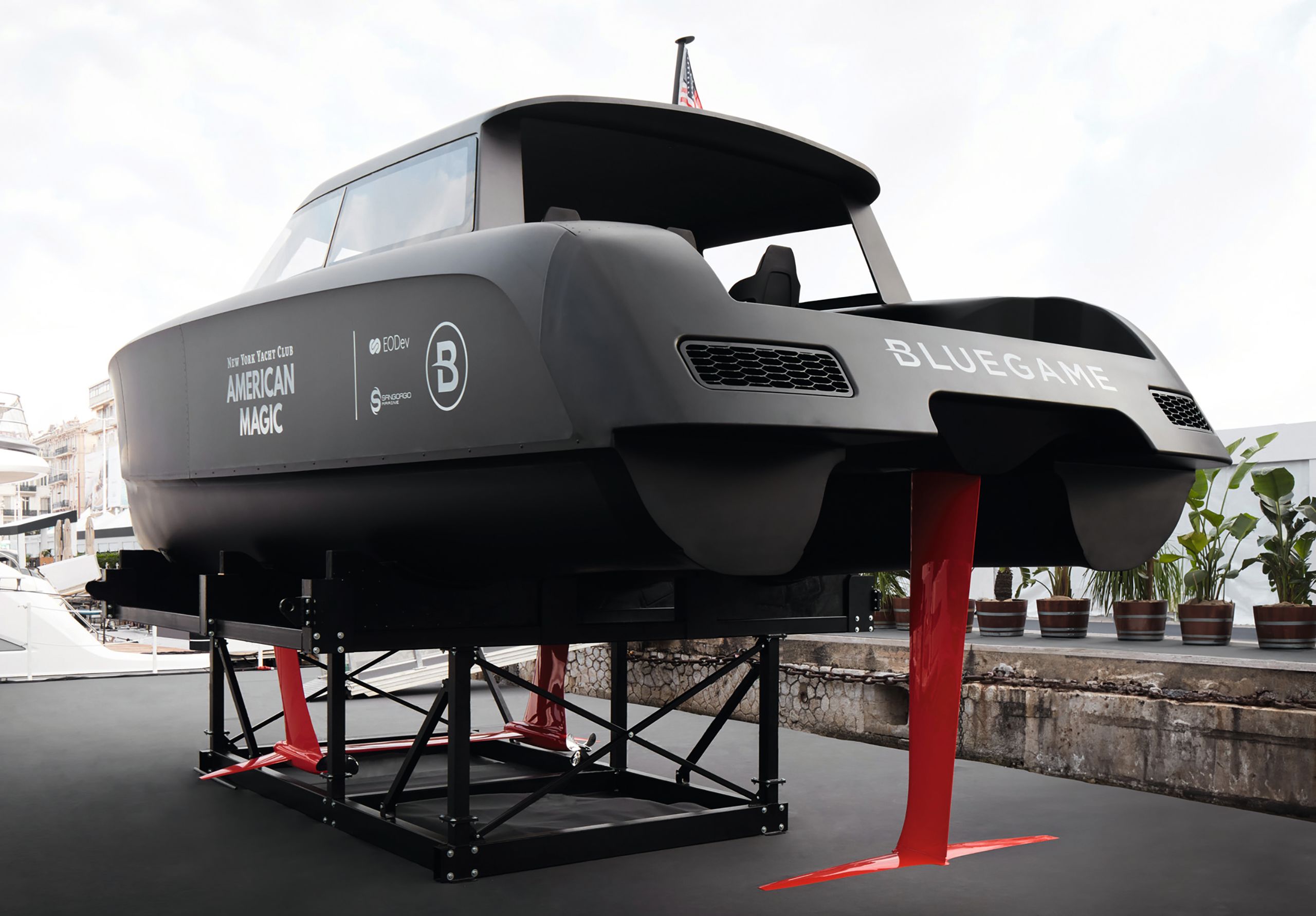
BLUEGAMEBluegame’s hydrogen-powered chaseboat for the US America’s Cup challenger
BLUEGAMEBluegame’s hydrogen-powered chaseboat for the US America’s Cup challenger
H2 and beyond
Early hydrogen yacht concepts, such as Sinot and Lateral Naval Architects’ beautiful 112-metre Aqua from 2019, relied on pure hydrogen as fuel. Feadship has recently revealed that it is well down this road with its 100-metre project – that is, with tonnes of liquid hydrogen stored in big tanks at -253 degrees C. “Cryogenic storage is a mature technology, because it’s the same as storage for liquid natural gas,” says Loeff. “But hydrogen has a higher risk profile, so there are a lot of extra hoops to jump through.”
The Feadship yacht will have a fuel cell measured in megawatts and enough hydrogen storage for several days of operation at a cruising speed of 12 to 13 knots. “The owner was prepared to invest money and time in researching what could happen with hydrogen. We started with limited knowledge and convened a load of experts,” says Jamie Edmiston, who brokered the sale. “It’s relatively rare, but you’ve got to have one person prepared to do it for the others to follow.”
“Safeguarding the sea is essential, as a common good of inestimable value”
However, fuel doesn’t have to be stored as pure hydrogen – you can also use hydrogen-rich liquids, such as methanol and ammonia; even solids like metal hydride. Loeff says he would plump for methanol if he were starting a new project today. “Methanol is a liquid at room temperature, and you can store it in tanks like diesel,” he explains. “You could have one storage system that could contain both fuels in tanks that are part of the structure of the boat. The problem with gas storage is that it has to be in space you could use for something else.”
Methanol is the fuel of choice for Lürssen’s Cosmos, too, which will feature two 500kW PEM fuel cells from Freudenberg. This will propel the Marc Newson-styled yacht at up to seven knots for a range of 1,000 nautical miles. As a prototype, however, the boat will still include all the usual diesel generators, engines and tanks needed to run in traditional internal combustion mode. “The fuel cell is just flanking the conventional generators. As you can imagine, we are building the first yacht with this technology and when you do research you also have to be prepared to fail,” says Michael Breman, Lürssen’s sales director.
NUCLEAR YACHTING
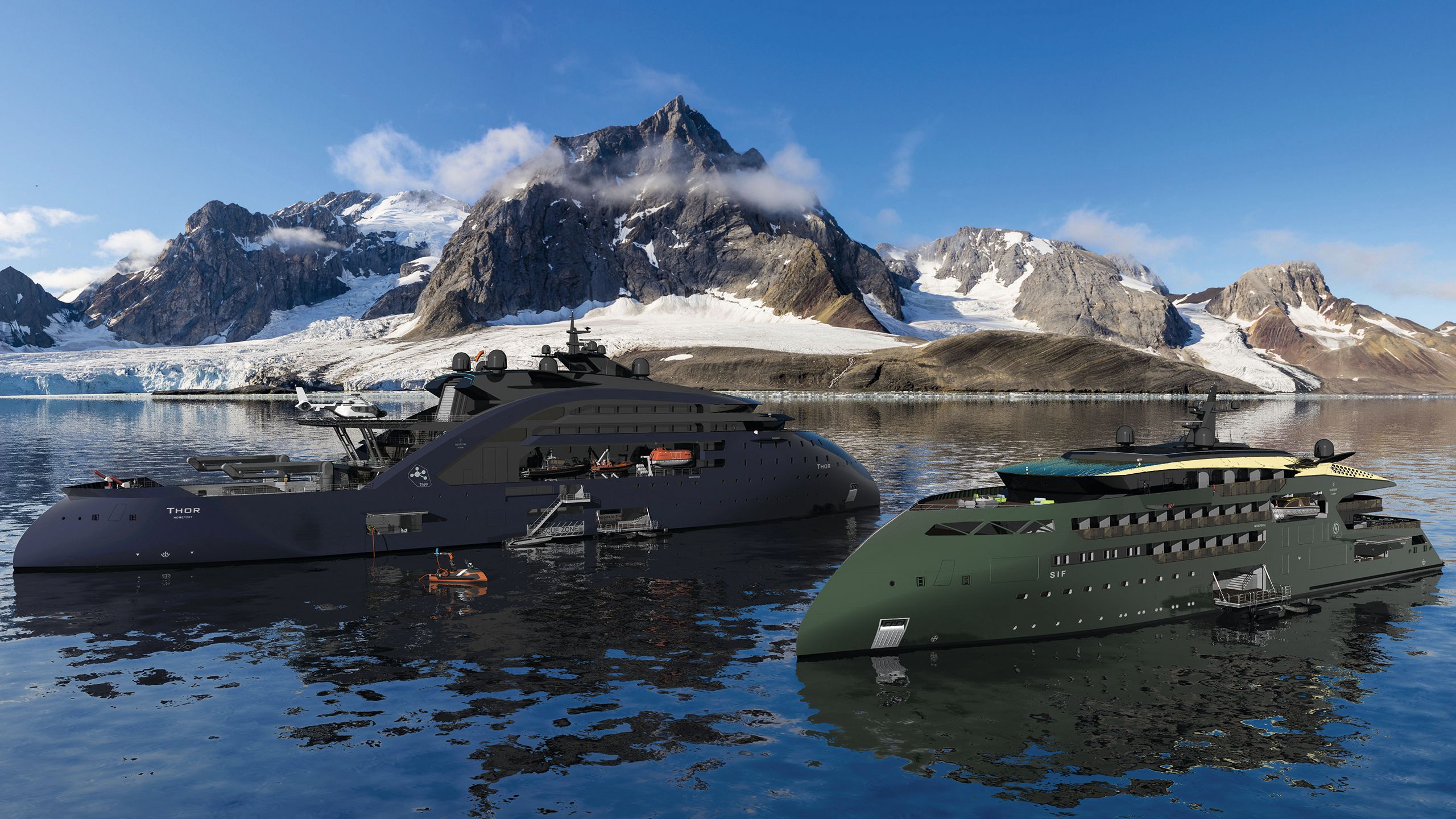
Military vessels have been powered by small nuclear reactors for years, but a new breed of thorium reactors could allow the technology to break into the commercial domain, according to the Norwegian shipbuilder Ulstein. The company claims thorium is safe, commercially proven and produces little waste.
Renowned for its development of the X-Bow hull form, Ulstein is a big hitter. So people took note when the company published a concept in 2022 for a thorium-powered ship that could act as a mobile charging station for electric-powered cruise ships. Called Thor, the ship’s heart was a 30MW molten salt reactor, or MSR.
Put Fukushima out of your mind for a second: the technology required can fit in an 8m x 8m x 8m concrete box. And although it does rely on nuclear fission to generate power, it is a more benign reaction using thorium chloride than you see with enriched uranium. First of all, it doesn’t need to be pressurised, which limits the potential for spreading radioactivity.
Then, the reaction can stop itself without external cooling – in the event of a problem the fuel would melt through a salt plug and drop into the concrete container, where the reaction stops instantly. The little waste generated by the reactor can’t be weaponised, and nor does it have a fraction of uranium’s radioactivity.
The theoretical cost for this technology compared to diesel generators producing electricity and the price per kWh is competitive,” says Øyvind Kamsvåg of Ulstein. “But only if you use the energy that the reactor can produce. If the superyacht is on the quayside a lot, then it will be very expensive. Luckily you can lease energy now, so you wouldn’t have to build the reactor.”
This scenario is still a way off, however. There is interest both from shipping companies and flag states. “The challenge now is scalability,” says Kamsvåg. “Manufacturers typically talk gigawatts, whereas we need megawatts. That, and public opinion. Realistically, it’s unlikely there would be anything ready before 2030.”
Sanlorenzo is the other major yacht builder that is developing hydrogen power as part of a €5m investment in the future, and its approach is twofold. Under its Bluegame brand, the Italian shipyard has built a beguiling 10-metre pure hydrogen chase boat for the US challenger in the 37th America’s Cup. The performance requirements are mind-boggling, with foiling speeds up to 50 knots, a range of 180 nautical miles and hours out on the water. But the more serious commercial project is the new 50Steel design whose hotel load is covered by a 100kW Siemens fuel cell running on methanol. “Methanol represents the best solution to replace diesel fuel, as it is already present in more than 100 ports around the world,” says Perotti firmly.
Then why, you might wonder, aren’t more new yachts being built with methanol fuel cells? Well, at one level it is disappointingly simple: litre for litre, hydrogen fuels contain less than half the energy of diesel. That means less than half the range under power, all while paying a heavy premium for the privilege.
However, fuel cell efficiency is already around 45 per cent, outstripping the humble diesel engine, and Siemens Energy says it will get better still. “The overall efficiency of high-temperature fuel cells can reach up to 80 to 90 per cent – even higher, with the integration of a combined heat and power system,” says Janet Ofano at Siemens.
And you have to look at the whole power train to gauge efficiency, not just the fuel in isolation. “The power density of methanol is significantly lower than diesel,” says Breman at Lürssen. “But there is actually less space needed in an engine room. Fuel cells don’t need silencers, no exhaust after-treatment, no complex fuel preparation, no complex storage and no soundproof cabin.” In the Sanlorenzo, this surprising finding has actually increased the amount of accommodation on offer in a feature dubbed the “hidden engine room”.
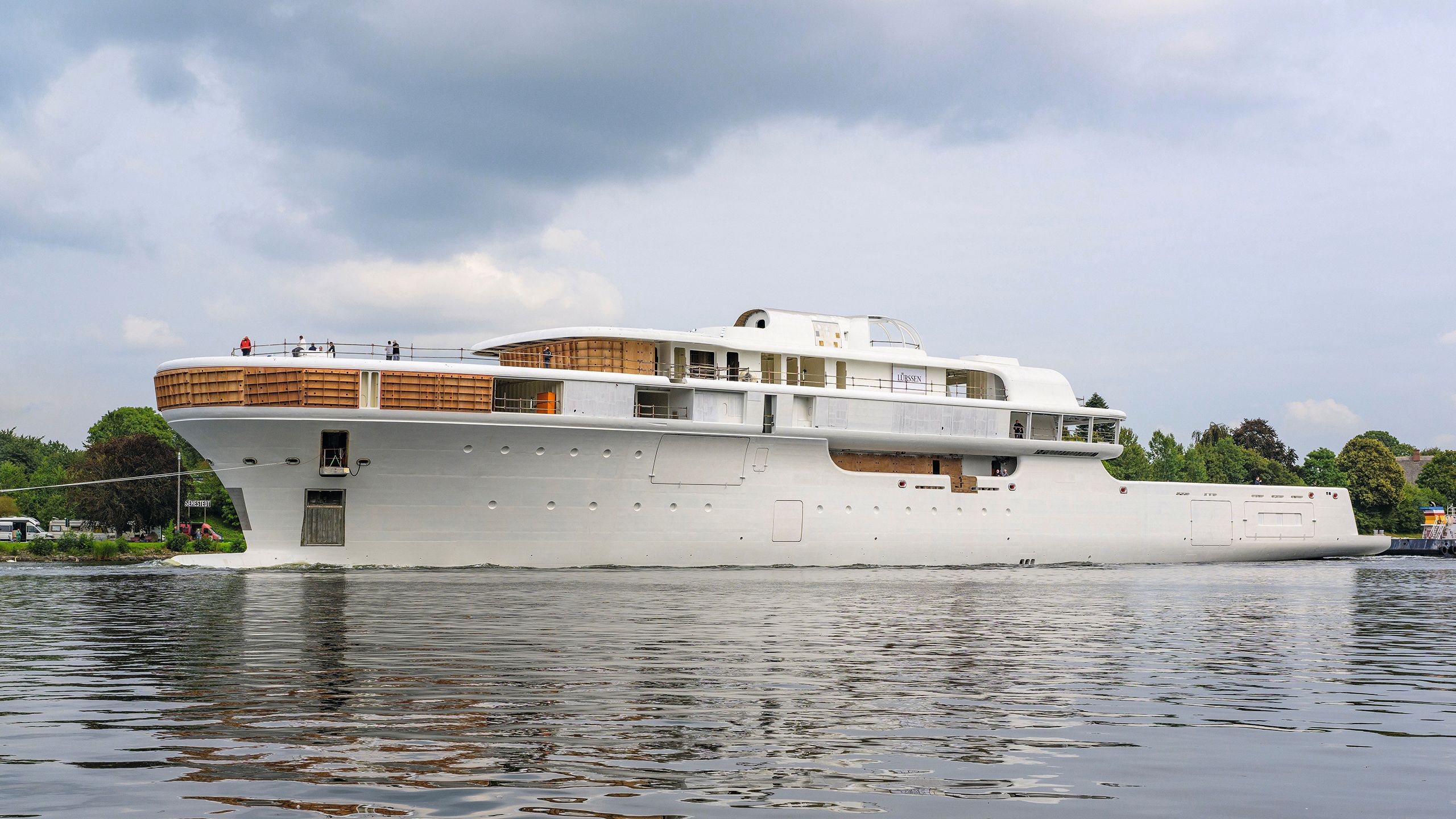
KLAUS JORDANLürssen’s 114m Cosmos is powered by methanol and will feature two 500kW PEM fuel cells from Freudenberg
KLAUS JORDANLürssen’s 114m Cosmos is powered by methanol and will feature two 500kW PEM fuel cells from Freudenberg
Ethical sourcing
There is another problem with methanol, though. In order to feed its hydrogen into the fuel cell, it must undergo an extra process. This is called steam reforming, which consumes energy and releases CO2 as a byproduct. In fact, kW for kW, methanol releases exactly the same amount of carbon as diesel. What is more, most of the world’s methanol is currently made from natural gas – a fossil fuel. So, you would be forgiven for questioning how low-carbon it really is. And here’s the thing: we already know how to manufacture “green” methanol from biomass or via carbon capture using renewable energy. And in that case, it can have as little as five per cent of the emissions of its fossil-fuel counterpart.
Currently, less than one per cent of the 100 million tonnes produced globally is produced in this way, but that picture is changing rapidly as firms scramble to invest in electrolysis plants. The Methanol Institute forecasts that eight million tonnes of green methanol will come on stream by 2027 alone. Bunkering prices simply don’t exist yet, but the commodity price of green methanol is around $400/t (approximately £320). With quayside diesel at $1,200/t, there is still a clear economic argument to methanol, even if it only contains half the energy.

COURTESY SANLORENZOThe kit for fuel cells takes up less space; Sanlorenzo calls the machinery space a Hidden Engine Room as it frees up more accommodation
COURTESY SANLORENZOThe kit for fuel cells takes up less space; Sanlorenzo calls the machinery space a Hidden Engine Room as it frees up more accommodation
It’s a similar story with pure hydrogen gas, where a pipeline of hundreds of green projects should add 10 million tonnes of new capacity by 2030, according to Fitch Solutions. But there’s still a job to be done getting these fuels to the quayside, even if methanol can be handled like diesel. And that’s because much of this new production is earmarked for commercial shipping. “Yachts will not be getting sustainable fuel in the mid-term,” says Christian Schweitzer of BSE Methanol. “To secure supply, it is only possible to build up dedicated capacities close to the marinas.”
His business has developed a drop-in methanol factory capable of producing 10 million to 20 million litres per year, which could easily be absorbed in key yachting hotspots around the Mediterranean. The kicker is that such plants could be supplied by wind power – harnessing excess electricity generated locally that the grid couldn’t otherwise handle.
Chris Warde of bunkering specialist Peninsula believes that superyacht owners might have to pump-prime supplies by financing the first plants themselves. “We’ve got the richest people in the world as our customers, but Bezos isn’t going to ring up Shell and ask for more biofuels,” he says. “Could those wealthy individuals contribute to decentralised production for those fuels? Absolutely. I can see a situation where small-scale green methanol production plants are financed by wealthy individuals around the areas they want to use their yachts.”
Regulation remains an issue, however – especially for pure hydrogen. In France, for instance, you can only bring 100kg of hydrogen on to port sites. Any more than that and you need a special dispensation from the port authority. More than a tonne of hydrogen and onerous industrial chemical rules dating from 2012 come into play. “Honestly, it’s not developing as fast as we’d want it to,” admits Laurent Perignon of EODev, which has industrialised the 70kW Toyota fuel cell used on the Bluegame chase boat. “Technologically speaking it’s all there, but what takes longest is for ports and marinas to validate the solutions – in which case, for the time being, mobile solutions remain the easier pathway.”
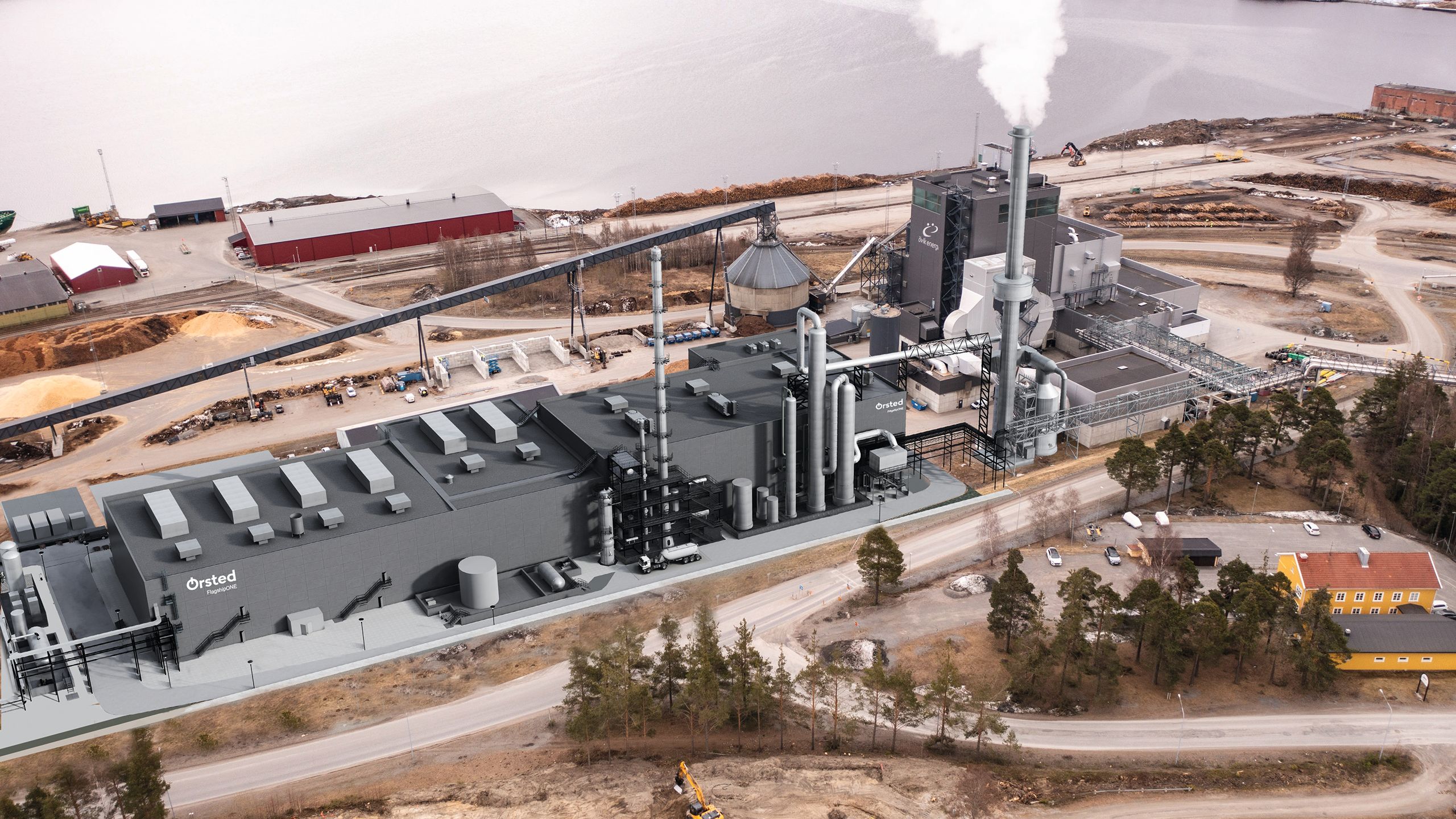
Producing 50,000 tonnes per year, FlagShipONE will be Sweden’s largest green methanol production site when it comes on stream in 2025
Producing 50,000 tonnes per year, FlagShipONE will be Sweden’s largest green methanol production site when it comes on stream in 2025
Stepping stones
If it is only the adventurous few ordering hydrogen superyachts now, there are still steps you can take towards zero-emissions yachting without scrapping the trusty diesel. Most ambitiously, you can get the engine converted to dual fuel so it can burn green methanol. It will still emit CO2, but the carbon in green methanol is part of a short cycle measured in months rather than the millennia of the fossil cycle. Engine makers are increasingly launching dualfuel engines that will allow new builds to use methanol from the off.
Only slightly less ambitious, biofuels provide a drop-in opportunity to slash the yacht’s carbon footprint by up to 70 per cent – if they have been sustainably sourced. FAME biodiesel has a mixed reputation in the marine sector because it absorbs water and can promote diesel bug [contamination], but hydrotreated vegetable oil (HVO) is a much cleaner product.
“We are building the first yacht with this technology and when you do research you also have to be prepared to fail”
It comes in two distinct varieties: the first derived from crops such as rape and oil palm, or a next-generation variety made from waste vegetable oil and biomass. They’re both better than standard diesel, but the devil is in the detail, as Peninsula’s Chris Warde explains. “If you’re using first-generation biofuels, you’re potentially contributing to agricultural problems – either moving arable land away from food production, or even worse, causing deforestation. We have to be really careful when we’re promoting biofuels.”
Peninsula only supplies second-generation HVO, which it supports with International Sustainability and Carbon Certification (ISCC). And you won’t be surprised to hear that it comes at a price. If standard HVO commands a 20 to 30 per cent premium over diesel, 2G fuel can be 90 per cent more expensive. That may be a drop in the ocean compared with crew costs, but it won’t win over all owners. In the end, Warde says that solving the issue of carbon emissions from yachts won’t come down to any single choice, but a series of stepping stones towards true sustainability. “It’s dangerous to be negative about any of the transitional fuels, because something is better than nothing,” he says. “We’re not going to come up with a silver bullet solution overnight – it’s going to be a process.”
First published in the June 2024 issue of BOAT International. Get this magazine sent straight to your door, or subscribe and never miss an issue.

